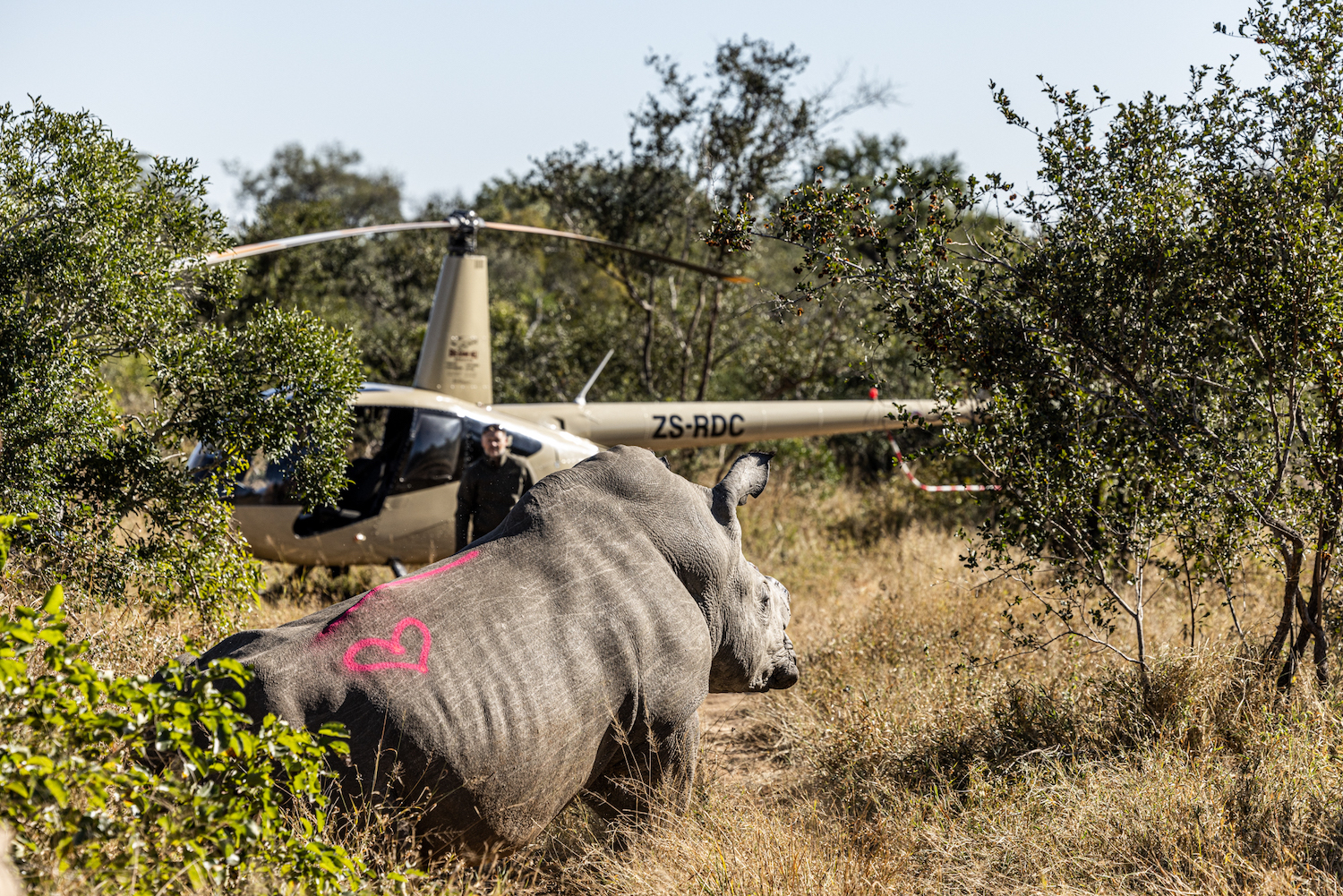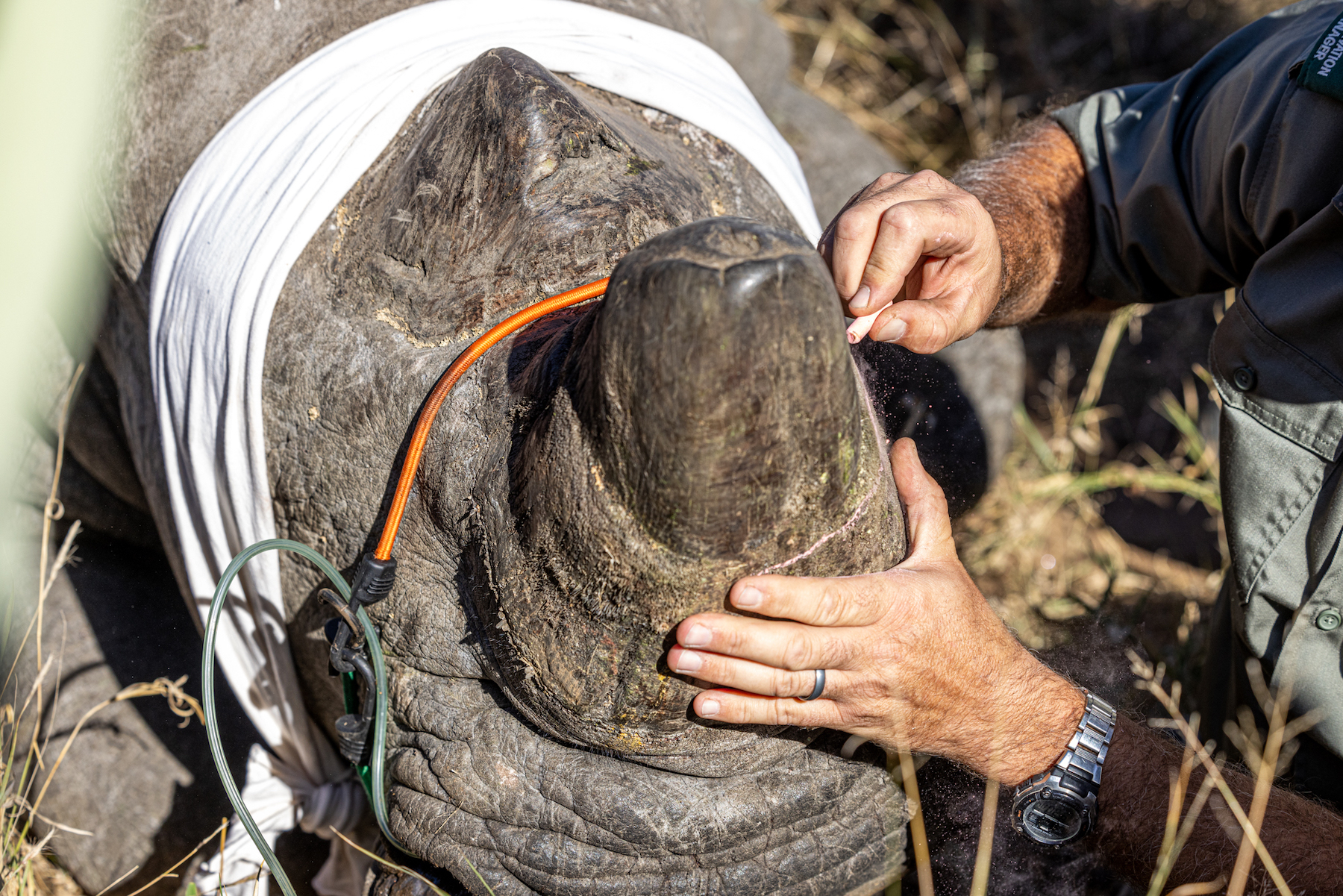By Rebecca L. Rhoades
Photography by Susan Richey
Poaching — the illegal hunting or capture of wildlife — is one of the largest threats to the survival of countless species across the globe. International syndicates traffic endangered species and their parts for use in traditional “medicines,” for the pet trade, and for display as status symbols.
In Africa, countless animals have seen their population numbers decline due to poaching. The continent is home to some of the world’s most majestic creatures, including elephants, lions and other wild cats, giraffes, and gorillas. Just over half a century ago, these animals could be found throughout the savannas and forests of central and southern Africa. Today, they are on the brink of extinction.
One of the most prized animals on the black market is the white rhinoceros, which is sought after for its horn. A single pound of rhino horn can sell for upwards of $30,000. But dedicated conservationists are working — and risking their lives — to protect this iconic species.

Rhino Wars
Just over a century ago, more than 1 million rhinos roamed Africa. Now, that number hovers around 22,000 — a reduction of about 97%. Poaching is the biggest threat to the species’ safety and survival.
There are two types of rhinos in Africa — blacks and southern whites. The black rhino, the smaller of the two, has a population of about 6,000 spread throughout the southern African countries. Southern whites number at slightly fewer than 16,000. At least three-quarters of those live in South Africa. Three additional species of rhinos — Sumatran, Javan, and greater one-horned — are found in Asia. The Javan rhino is one of the rarest animals on earth, with fewer than 80 remaining. The northern white, once found in abundance throughout central Africa, has been hunted into near extinction. The last male northern white rhino died in 2018, and the two surviving females are too old to reproduce.
“South Africa is home to 80 percent of the world’s rhino population, so this is where the most rhino poaching on earth happens,” says Joe Pietersen, founder of Nkombe Rhino, a nonprofit that focuses on the protection of endangered species.
Most of the rhinos in South Africa reside on private lands. In neighboring countries, such as Zimbabwe, Namibia, Mozambique, and Zambia, game animals fall under government care — and the only people who can intervene in their protection are government-appointed officials.
“Because private individuals in South Africa can own land and fence it in, they’re allowed to own endangered species. That means that the private sector can determine what happens to best care practices,” Pietersen says. “That’s why, if you look at the amount of endangered species in South Africa, as well as the number per species, you will see that it’s much higher than across the rest of the continent.”
Pietersen, a South African rugby star who also played for the San Diego Legion from 2018-2022, started his organization in 2010 during the peak of the rhino wars, when poachers were slaughtering the animals at a nightmarish rate and putting them at high risk for extinction. Nkombe Rhino also supports a variety of conservation and community projects, including providing water for elephants, relocating wild dogs, and collaring lions, as well as providing food and clothing for rural villages.
The current rhino-poaching crisis in South Africa began in 2007 with the loss of 13 rhinos and escalated to 1,215 killed for their horns in 2014 — a more than 9,000% increase. While that number has decreased thanks to public awareness and conservation campaigns, the country still loses one rhino to poaching every 20 hours. According to international conservation charity Save the Rhino, 448 rhinos were killed in South Africa in 2022.
The illegal trade is driven by Asian appetite for horns.
“The East, mostly Laos and China, have traditional medicinal beliefs attached to special species,” Pietersen explains. “Rhino horn, if you grind it up in a bowl, mix it with water, and drink it, it helps fight cancer, cures headaches and impotency, and is an aphrodisiac.”
In Vietnam, where powdered horn is touted as a hangover cure and cancer treatment, demand has skyrocketed. Scientifically, rhino horn has no proven benefits.
Rhino horns also are seen as status symbols. Rich buyers snap up carvings, cups, beads, and jewelry for display or as investments.
“In countries like Yemen, they use rhino horn for dagger handles,” Pietersen adds. “It’s an elite show of wealth.” He continues, “It’s funny how they don’t go for sheep or cattle. It’s always products from endangered species.”

Anti-poaching Protection
The horn itself is composed of keratin, the same materials as human fingernails and hair, as well as horse hooves. And unlike elephant tusks, which are made of ivory — deep rooted like teeth and do not grow back — rhino horn continues to generate throughout the animal’s lifetime. But just like human nails, the horn has a blood supply, and if the horn is cut below the quick, the animal can bleed to death.
Poachers do not care. Under the cloak of night, sophisticated crews trespass on private lands, as well as on such renowned reserves as Kruger National Park in the northeastern part of the country and Hluhluwe Imfolozi in KwaZulu Natal. The poachers track the rhinos and shoot them with high-powered rifles. Oftentimes, they will further immobilize the rhino with a machete strike to the spine. The horn is then violently hacked off within minutes using a machete, leaving the rhino to bleed out.
In an effort to protect the dwindling numbers of rhinos, wildlife managers began sawing off the horns. This practice, which first started in Namibia in 1989, picked up steam in the mid-2010s.
“De-horning is a preventative measure. It’s not a stand-alone silver bullet solution,” Pietersen says. “The incentive now for poachers to go into a reserve and poach that animal — and potentially get caught by anti-poaching forces — is no longer good enough.”
Nkombe employs a team of skilled pilots, guides, and veterinarians, who work quickly and efficiently to implement this safeguard. A small fixed-wing plane is used to locate the animal, and a ground crew then moves in on its location. From a helicopter, a veterinarian darts the rhino with a tranquilizer.
“At that time, we’ve got four or five minutes before the animal goes down. From that point on, all of our attention goes toward the animal’s well-being,” Pietersen says. “Remember, this is a 5,000-pound animal. If it lays in an unnatural position, it’s probably going to suffocate, so you want to make sure it’s in a non-compromised position and breathing naturally.”
The team covers the rhino’s eyes and ears, and the horn is removed using a chainsaw.
“As long as you don’t cut into the bed, it’s pain-free,” Pietersen explains. The blood vessels extend about three inches into the horn, or about the width of four fingers. “That is the piece you want to avoid cutting.”
Once the horn is removed, the remaining keratin material around the nerve is ground smooth, and the stump is cleaned and treated with an antiseptic for additional protection. An antidote is administered through a catheter into the ear to awaken the rhino.
“All of this takes about 25 minutes,” Pietersen says.
During the process, a DNA sample is taken from the rhino. This is cataloged along with DNA from the horn in a groundbreaking database known as RhODIS (Rhino DNA Indexing System). Each animal has a specific fingerprint or barcode that is unique to it. This information helps police to link poachers and traffickers to crime scenes. The removed horns are placed in storage and are not available for public consumption.
An Ethical Solution?
The de-horning process is not without its concerns. First, it is expensive. It costs about $1,500 per animal. “It’s also unsustainable because it has to be done every 18 to 24 months,” Pietersen points out.
It’s also, from an outside viewpoint, an intrusive and stressful procedure. Pietersen insists that the stress is relatively minimal.
“The only thing that’s unnatural is the loud helicopter chasing them to run for four to six minutes, which is something rhinos don’t do,” Pietersen explains. “But if you’ve ever taken a shot in your arm and then clipped your fingernails, as long as that pain lasts, that’s what they’re going through.”
Another debate is whether or not rhinos actually need their horns to survive. The animals use their horns to defend their territories, protect calves from predators, and fight in mating battles. Fully grown rhinos have few natural predators: people are their number one enemy.
A 2022 study on the effect of dehorning black rhinos in Namibia — published in the European Journal of Wildlife Research — showed that the process had no effect on reproduction, calf survival, cause of death or lifespan.
However, another study, reported in June 2023 in the Proceedings of the National Academy of Sciences, found that the practice makes the animals roam less widely and interact less with other rhinos. Researchers studying black rhinos in 10 game reserves in South Africa found that when rhinos were dehorned, their territory shrank on average by nearly 12 square kilometers, or 45 percent of their range prior to dehorning. The researchers expressed concerns that dehorning might be inadvertently domesticating rhinos. Such issues, they say, will likely take years to determine.

Even with all of the concerns and unknowns, dehorning remains the most effective deterrent against poaching.
“You have to remember that we are working with something wild. We must not attach human feelings to them,” Pietersen says. “The moment you’re on the ground, it’s a different perspective than the one we create in the First World. Things work in the First World; they don’t work out here. We have to come up with different solutions. The ideal and the practice are far removed.”
“But the care and well-being of the animal are by far number one,” he adds. “And even if it is stressful or causes a little pain, it’s still better than death.”
For more information, visit nkomberhino.org.
Socially Minded Safari
When Phoenix-based artists April Howland and Susan Richey formed their tour group, Adventure Artists International, their goal was to offer exciting trips that would inspire their guests to create paintings and photographs of Africa’s natural beauty.

Howland is a renowned painter who specializes in animals, both wild and domestic. She’s a co-founder of the Phoenix Zoo’s Art on the Wild Side program, which uses artwork to increase attention to the beauty and issues of the natural world.
Richey is a photographer whose wildlife and travel images showcase her love of nature and animals. Through her Good Focused Photo Program, she provides free photography services to animal rescue and conservation organizations to help raise awareness and increase adoptions.
Then they met Joe Pietersen, founder of Nkombe Rhino, at a South African based conversation organization.
Howland and Richey were introduced to Pietersen by Dr. Peter Rogers, a world-renowned wildlife veterinarian and conservationist who works closely with Nkombe Rhino. Howland had met Rogers in Africa in 2021. “We did a rhino dehorning, and I asked him how we can get more involved,” she says.
After a couple of conversations, the trio guided their first tour in 2022.
“I think it’s important for people to not only see the romantic Africa but also to experience what’s happening on the ground,” Pietersen explains.
AAI now offers a couple of conservation trips for small groups to Africa each year. The experience includes wildlife game drives, rhino dehorning and elephant collaring, community service activities, and visits to some of the most breathtaking landscapes in up to three countries.
“It’s remarkable to see the impact a trip like this has on people. It’s something that they take with them for the rest of their lives. And hopefully that trickles down into more people caring for the natural world,” Howland says.
Richey adds, “It’s rare to be able to get into this world of conservation. We’re very fortunate that Joe welcomed us into his world and provided these opportunities. www.adventureartistsinternational.com.
Read more Good articles on Green Living.






